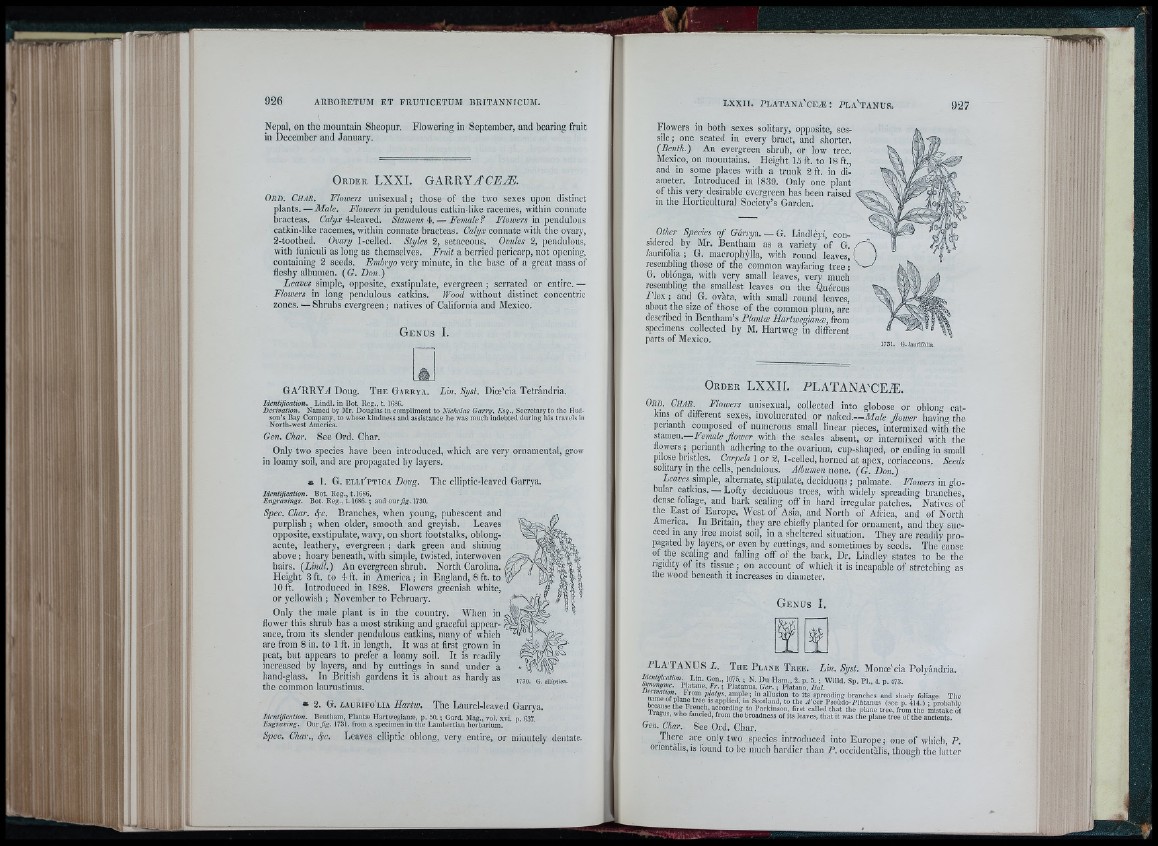
■i'!
tel
Nepal, on the ;he mountain Sheopur.SI:
Flowering in September, and bearing fruit
' De
in December and January.
O r d e r L X X I . G A R R Y ^ 'C i:^ .
OliD. Ch a r . Floiuers unisexual; those of the two sexes upon distinct
plants.—Male. Flowers in pendulous catkin-like racemes, within connate
bracteas. Calyx ^-leaved. Stamens 4.— Female? Fiowers in pendulous
catkin-like racemes, within connate bracteas. Calyx connate with the ovary,
2-toothed. Ovary 1-celled. Styles 2, setaceous. Ovules 2, pendulous,
with funiculi as long as themselves. Fruit a berried pericarp, not opening,
containing 2 seeds. Fmbryo very minute, in the base of a great mass of
fleshy albumen. (G. Bon.)
Leaves simple, opposite, exstipulate, evergreen; serrated or entire.—
Flowers in long pendulous catkins. Wood without distinct concentric
zones. — Shrubs evergreen; natives of California and Mexico.
G e n u s I.
GA'RKYod Doug. T h e G a r r y a . Lin. Syst. Dioe'cia Tetrandria.
IdentiJicaUon. Lindl. in Bot. Reg., t. 168G.
Derivation. Named by Mr. Douglas in compliment to Nicholas Garry, Esq., Secretary to the Hudson’s
Bay Company, to whose kindness and assistance he was much indebted during his travels in
North-west America.
Gen. Char. See Ord. Char.
Only two species have been introdaced, which are very ornamental, grow
in loamy soil, and are propagated by layers.
tt 1. G. E L L i'P T iC A Z)o2£g. The clliptic-leaved Giiri’ya.
Identification. Bot. Reg., 1.1686.
Engravings, Bot. Reg., 1 .1686. ; and ourfig. 1730.
Spec. Char. 4'C. Branches, when young, pubescent and
purplish; when older, smooth and greyish. Leaves
opposite, exstipulate, wavy, on short footstalks, oblong-
acute, leathery, evergreen ; dark green and shining
above; hoary beneath, with simple, twisted, interwoven
hairs. (Lindl.) An evergreen shrub. North Carolina. (
Height 3 ft. to 4ft. in America; in England, 8 ft. to
10 ft. Introduced in 1828. Flowers greenish white,
or yellowish ; îiovember to February.
Only the male plant is in the country. When in
flower this shrub has a most striking and graceful appearance,
from its slender pendulous catkins, many of which
are from 8 in. to 1 ft. in length. It was at first grown in
peat, but appears to prefer a loamy soil. It is readily
increased by layers, and by cuttings in sand under a
hand-glass. In British gardens it is about as hardy as
the common laurustinus.
* 2 . G. L a u r i f o ' l i a Hartw. The Laurel-leaved Garrya.
Identification. Bentham, Plantæ Hartwegianæ, p. 50. ; Gard. Mag., vol. xvi. p 637
Engraving. O u r/ig . 1731. from a specimen in the Lambertian herbarium.
Spec. Char., {¡c. Leaves elliptic oblong, very entire, or minutely dentate.
Flowers in both sexes solitary, opposite, sessile;
one seated in every bract, and shorter.
(Benth.) An evergreen shrub, or low tree.
Mexico, on mountains. Iieight 15 ft. to IS ft.,
and in some places with a'trunk 8 ft. in diameter.
Introduced in 18.39. Only one plant
of this very desirable evergreen has' been raised
in the Horticultural Society’s Garden.
Other Species o f Gárrya. — G. Lindlèyi, considered
by Mr. Bemham as a variety of G.
/aurifòlia ; G. macrophylla, with round leaves,
resembling those of the common wayfaring tree ;
G. oblónga, with very small leaves, very much
resembling the smallest leaves on the «uércus
/'lex ; and G. ovata, with small round leaves,
about the size of those of the common plum, are
described in Bentham’s Planta! Hartwefiarvce, from
specimens collected by M. Hartweg in different
parts of Mexico. 1731. G./aurifòlia.
O r d e r L X X I I . PLATAN A'CE.® .
Or d . Ch a r . Flowers unisexual, collected into globose or oblong catkins
of different sexes, involucrated or naked.— Male fiower having the
perianth composed of numerous small linear pieces, intermixed with the
nHwen.— Female flower with the scales absent, or intermixed with the
fiowers; perianth adhering to the ovarium, cup-shaped, or ending in small
pilose bn,sties. Carpels 1 or 2, 1-celled, horned at apex, coriaceous. Seeds
solitary m the cells, pendulous. Albumen none. (G. Bon.)
Leaves simple, alternate, stipulate, deciduous; palmate. Flowers in globular
catkins. — Lofty deciduous trees, with widely spreading branches,
dense foliage, and bark scaling off'in hard irregular patches. Native.s of
the East of Europe, West of Asia, and North of Africa, and of North
America. In Britain, they are chiefly planted for ornament, and they succeed
in any free moist soil, in a sheltered situation. They are readily propagated
by layers, or even by cuttings, and sometimes by seeds. The cause
of the scaling and falling oiF of the bark, Dr. Lindley states to be the
rigidity of its tissue; on account of which it is incapable of stretching as
the wood beneath it increases in diameter.
G e n u s I.
PLATANUS T h e P l a n e T r e e . Lin. Syst. Monoe'cia Polyándria.
Identification. Lin. Gen., 107.5. ; N. D u Ham., 2. p. 5. : Willd. Sp Pl 4 n 473
Synonyme. Platane. Fr. ; Platanus. Ger. ; Plàtano, i r il. ^
namp T " i f i allusion to its spreading branches and shady foliage. The
beSu«P applied, m Scotland, to the .4'cer Pseùdo-Flâtanus (see p. 414.■) ; probably
i S « Î L f ® 1° Pf'-l'inson, first called that the plane tree, f rW the mistake 6i
Tragus, who lancted, from tlie broadness of its leaves, that it was the plane tree of the ancients.
Gen. Char. See Ord. Char.
There are only two species introduced into Europe; one of which,
ouentalis,is found to be much hardier than P. occidentàlis, though the latter